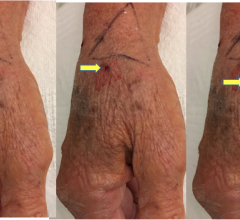December 30, 2011 – The Society for Cardiovascular Angiography and Interventions (SCAI) published a paper that examines the value, technique and best practices for performing angioplasty via the radial artery in the wrist. The paper, titled “Transradial Arterial Access for Coronary and Peripheral Procedures: Executive Summary by the Transradial Committee of the SCAI,” appears in a special themed issue of Catheterization and Cardiovascular Interventions on the transradial access procedure.
During transradial coronary intervention, a catheter is inserted into the radial artery in the wrist as part of a procedure to open blocked heart arteries. Currently, most coronary intervention procedures use an access point in the larger femoral artery in the groin. Accessing the heart arteries through the wrist is less invasive, often resulting in less discomfort for the patient. And, unlike femoral access, the patient is able to stand and walk immediately following the procedure. These benefits, along with reliable access to the coronary arteries, have led to an increase in transradial coronary interventions both nationally and globally, outpacing femoral access in some countries. In the United States alone, there has been an 8 to 10 percent increase in the use of transradial coronary interventions, and this trend is expected to continue.
“The technique will only continue to gain ground as more interventional cardiologists and patients realize its capabilities as a less invasive, effective route with fewer risks and complications,” said Ronald P. Caputo, M.D., FSCAI, St. Joseph’s Hospital, SUNY Upstate Medical School, Syracuse, N.Y., and lead author of the paper. “This is the first time the procedure in its entirety has been addressed in a single document. The document offers a valuable resource for interventional cardiologists before they start using the procedure. It’s a one-stop source for transradial coronary intervention.”
Data analyzed for the paper published show fewer risks and complications associated with transradial coronary interventions. Unlike other access sites, transradial coronary intervention provides easy compressibility and distance from major vessels and nerves. Compared with the femoral approach, it has achieved significant reductions in bleeding and access site complications. Fewer complications can impact the length of hospital stays, potentially reducing costs and improving clinical outcomes. The paper also states that patient preference leans toward radial access due to increased functioning, less discomfort and, for some patients, the option of same-day discharge from the hospital.
“Transradial access has great promise for improving patient comfort and outcomes,” said Christopher J. White, M.D., FSCAI, SCAI president and professor and system chairman of cardiovascular diseases at the John Ochsner Heart & Vascular Institute, New Orleans, La. “Transradial coronary intervention is a good example of our efforts to improve quality of patient care by offering new options for patients. These innovative advancements improve the overall patient experience on multiple levels – comfort, safety, function and cost.”
The paper guides interventional cardiologists through patient selection, pre-procedural preparation and training and credentialing. Highlights of the paper include:
· Guidance on patient selection. The paper addresses how variables such as hemodynamic status, age, history of past transradial procedures and the status of the radial artery should be used to determine which patients are the best candidates for transradial coronary interventions.
· Determining which artery in the wrist to use. Based on the individual patient, the physician decides which artery in the wrist is best and whether to use the left or right arm.
· Overcoming complications and how to prevent them. Complications that may occur during transradial coronary intervention include spasm, bruising and artery dissection or perforation.
“Transradial Arterial Access for Coronary and Peripheral Procedures: Executive Summary by the Transradial Committee of the SCAI,” along with the full issue of Catheterization and Cardiovascular Interventions, is available at http://onlinelibrary.wiley.com/doi/10.1002/ccd.23052/pdf or via www.scai.org.


 May 19, 2022
May 19, 2022 








